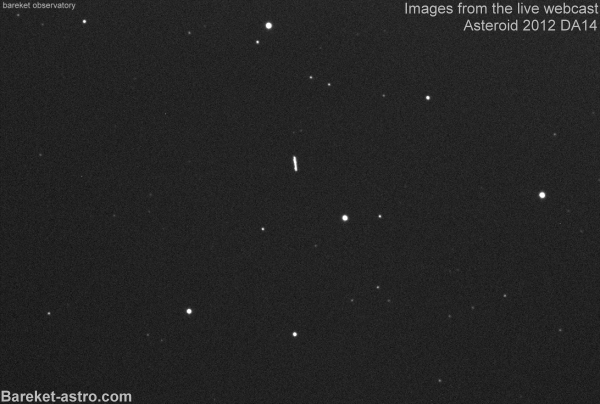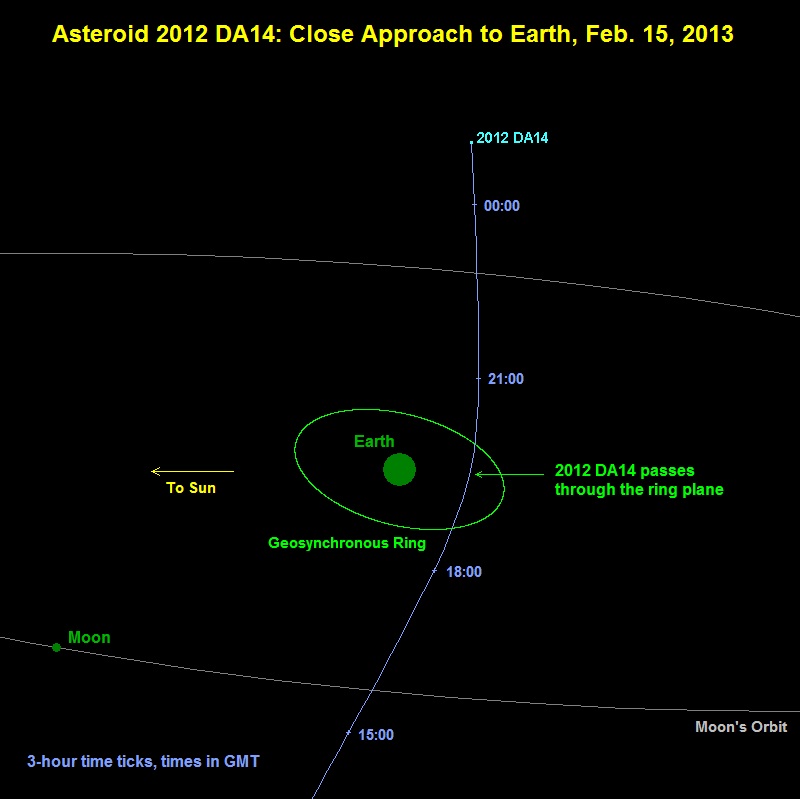A near-Earth asteroid swept safely past Earth on February 15, 2013, and astronomers in many parts of the world were ready with cameras and video equipment. At its closest to us, asteroid 2012 DA14 was within the orbit of the moon (which averages about a quarter million miles away), and closer than some high-orbiting communications satellites. Its closest point was about 17,200 miles (27,680 kilometers) away. The asteroid was not visible to the eye as it sped harmlessly past, but earthly cameras captured it, and millions watched online in real time.
The image below is from Bareket Observatory in Israel, which had a live webcast of the asteroid passage on February 15. The video below that is also from Bareket. Ido at Bareket Observatory told EarthSky:
The data stream was enormous, with more than 150K viewers overall … We continued the webcast up to about 0300am local time, much longer than the initial schedule. The feedbacks were amazing, from all over the globe.

Next, here’s a movie from the Samford Valley Observatory in Brisbane, Australia. It shows the progress of asteroid 2012 DA14 across the night sky as it neared its closest approach on February 15. Astronomers captured this video approximately six-and-a-half hours prior to the asteroid’s closest approach. The movie has been sped up 50 times.
Meanwhile, only hours before the asteroid’s closest approach to Earth, a meteor exploded in the air over Russia, injuring nearly 1,000 people, according to media reports. Although asteroids are known to sometimes have their own moons, or travel in swarms, NASA later said the meteorite was not associated with asteroid 2012 DA14.
NEWS. Meteor over Russia early in the day on Friday, February 15. More than 1,000 people hurt. INFO AND VIDEO HERE.
Russian meteorite not related to asteroid 2012 DA14 flyby, NASA says


Asteroid 2012 DA14 was not at any time visible to the eye, but observers with telescopes captured views of it throughout the event. Who saw the February 15 asteroid flyby?
The main asteroid – 2012 DA14 – was never expected to strike us in 2013, NASA always said. There was a remote possibility it might strike us in 2020, but that possibility has been ruled out also.


What happened when Asteroid 2012 DA14 passed closely in 2013?
Most of us could not see the large asteroid 2012 DA14, except via online broadcasts. And, by the way, this asteroid was not large enough to alter the tides. It could not (and did not) cause volcanoes. It just swept closely and safely past us – as millions of asteroids have done throughout Earth’s four-and-a-half-billion-year history – some in your own lifetime.
Asteroid 2012 DA14 was within range of small telescopes and solidly mounted binoculars, used by experienced observers who have access to appropriate stars charts. Indonesia was favored for viewing, because it was the middle of the night there when the asteroid was closest. Europe and the Middle East were also in a location to view the asteroid, potentially. But this was a challenging observation. Even those familiar with using binoculars and telescopes needed prior experience to track the object as it moved rapidly across the sky. Read more about who could see asteroid 2012 DA14 here.
Geologist and astrophotographer Colin Legg in Australia captured the wonderful video below, in which he caught a decaying meteor train plus the asteroid 2012 DA14 moving in the same frame. He said it was “luck,” but if you’ve seen any of Colin’s other work in astrophotography, you know there was huge skill involved, too. He wrote:
I captured this footage starting 3.24 am from a dark sky site 350 km east of Perth. Just after camera rolling, a beautiful meteor burned across the sky, and amazingly, passed right through my camera’s field of view, lingering while the debris train swept up and out of view. In addition, the sky was also very busy swarming with countless man made satellites. The asteroid is the bright object at left moving down the screen.
Closest Earth approach of asteroid 2012 DA14 occurred about 19:26 UTC when the asteroid achieved a magnitude of less than seven, which is somewhat fainter than naked eye visibility. About 4 minutes after its Earth close approach, the asteroid was expected to pass into the Earth’s shadow for about 18 minutes or so before reappearing from the eclipse.
What do we know about asteroid 2012 DA14?
Asteroid 2012 DA14 is a little guy, compared to some asteroids. It is thought to be about 45 meters across (nearly 150 feet across), or about the length of half an American football field. Its estimated mass is about 130,000 metric tons.
If a space object 150 feet wide were to strike our planet, it wouldn’t be Earth-destroying. But it has been estimated that it would produce the equivalent of 2.4 megatons of TNT. How does that compare with other known impact events on Earth? In 1908, in a remote part of Russia, an explosion killed reindeer and flattened trees. But no crater was ever found. Scientists now believe a small comet struck Earth. That event has been estimated at 3 to 20 megatons. So 2012 DA14 is in the same approximate realm as the Tunguska comet (which, actually, might have been an asteroid instead). It would not destroy Earth, but it could flatten a city.
Of course, about 70% of our world is covered by oceans. That means the most likely landing spot of any incoming asteroid is in the water – not on a city or other populated area.
Astronomers at the Observatorio Astronómico de La Sagra in Spain discovered 2012 DA14 in early 2012. We know 2012 DA14’s orbit is similar to that of Earth. That is one reason the asteroid eluded astronomers until recently. Astronomers will be tracking 2012 DA14 in the future. The video below is from NASA, which broadcast a live webcast during closest approach on Friday, featuring commentary and images from telescopes around the world.
Will 2012 DA14 strike Earth in 2020?
No. In March 2012, when a collision between 2012 DA14 and Earth in 2020 was still remotely possible, I asked astronomer Donald Yeomans to clarify the risk. Yeomans is, among other things, manager of NASA’s Near-Earth Object Program Office at NASA’s Jet Propulsion Laboratory. In March 2012, he told EarthSky that a 2020 collision between Earth and asteroid 2012 DA14 was …
… approximately one chance in 83,000, with additional remote possibilities beyond 2020. However, by far the most likely scenario is that additional observations, especially in 2013, will allow a dramatic reduction in the orbit uncertainties and the complete elimination of the 2020 impact possibility.
It turned out they didn’t have to wait until 2013. By May, 2012, astronomers had ruled out even the remote possibility of a 2020 collision.
Astronomers say that 95% of asteroids large enough to do damage on Earth are now known. Still, 2012 DA14 and asteroids like it are sobering.

Bottom line: Look here for photos and video from the near-Earth passage of asteroid 2012 DA14, which within 21,000 miles of Earth on February 15, 2013. Meanwhile, a meteor exploded in the air above Russia early in the day on February 15. Although asteroids do sometimes have moons, or travel in swarms, NASA said the meteorite was not associated with asteroid 2012 DA14.











